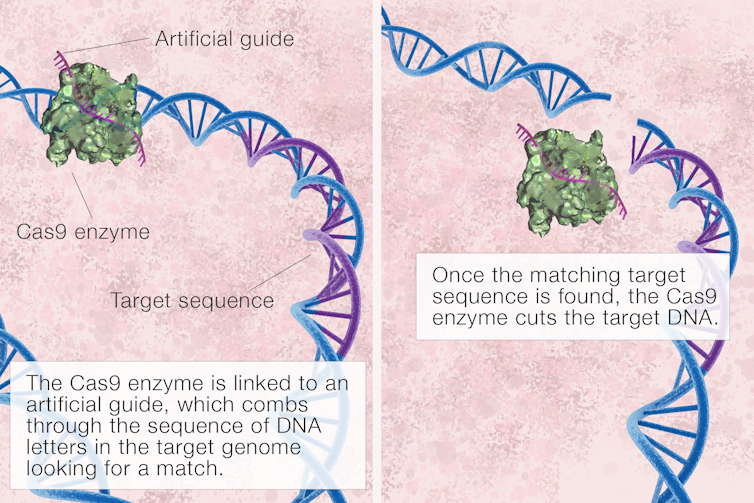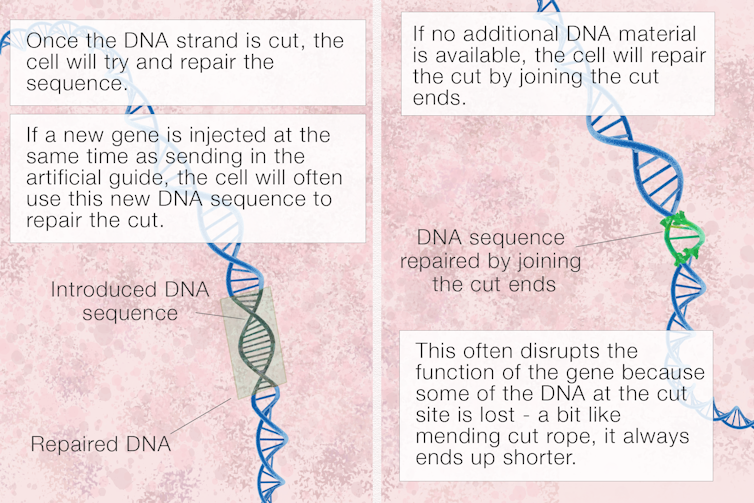How Can Crispr-cas9 Be Tailored to Target Different Genes?
You've probably read stories about new research using the gene editing technique CRISPR, as well called CRISPR/Cas9. The scientific globe is absorbed by this revolutionary technology, since it is easier, cheaper and more efficient than previous strategies for modifying Dna.
The term CRISPR/Cas9 stands for Clustered Regularly Interspaced Short Palindromic Repeats/CRISPR associated protein 9. The names reflect important features identified during its discovery, only don't tell u.s. much about how it works, as they were coined before anyone understood what information technology was.
What does CRISPR/Cas9 exercise?
CRISPR/Cas9 is a organisation found in bacteria and involved in allowed defence. Leaner apply CRISPR/Cas9 to cut upwardly the DNA of invading bacterial viruses that might otherwise kill them.
Today we've adapted this molecular machinery for an entirely different purpose – to modify any chosen letter(s) in an organism's DNA code.
We might want to correct a affliction-causing mistake that was inherited or crept into our DNA when it replicated. Or, in some cases, we may want to enhance the genetic code of crops, livestock or peradventure even people.
And then practise we just snip the unwanted gene out and replace it with a adept one?
Baca juga: Explainer: what is genome editing?
We first take to remember that animals and plants are composed of millions of cells, and each cell contains the same Dna. There is no point editing but one cell: we would accept to edit the same cistron in every single cell. Nosotros'd accept to snip out millions of genes and paste in millions of new ones.
And not all cells are piece of cake to become to – how could we reach cells cached in our basic or deep inside a encephalon?
A better approach is to beginning at the commencement and edit the genome while there is only 1 jail cell – a very early embryo.
And then, all we demand is a giant microscope and a tiny pair of scissors. And that is basically what nosotros use.
Cas9 is the technical name for the virus-destroying "scissors" that evolved in bacteria. The CRISPR part of the name comes from repeat DNA sequences that were part of a complex organisation telling the scissors which function of the Dna to cut.
Find, cut and then paste
In order to target our Cas9 scissors, we link them to an bogus guide that directs them to the matching segment of Deoxyribonucleic acid.

Remember, Dna comes in two strands, with one strand fitting alongside the other. We make a guide with a code that will line up with but one part of our 3 billion base pair long genome – information technology'due south like a "Google" search. It's truly possible for our guide to comb through vast amounts of genetic fabric to detect the 1 section information technology matches exactly. Then our "scissors" can make the cut in exactly the right place.
Once the Cas9 scissors cut the Deoxyribonucleic acid just where we intend, the cell volition try to repair the break using whatsoever bachelor Dna it can find. Then, we as well inject the new cistron we want to insert.

Baca juga: Now we can edit life itself, we need to ask how we should use such technology
You tin utilize a microscope and a tiny needle to inject the CRISPR/Cas9 together with the guide and the donor DNA, the new gene. Or, you can punch holes in cells with electric currents and permit these things but float in, apply guns to shoot them in stuck-on tiny bullets, or introduce them encapsulated in bubbling of fat that fuse with the prison cell membrane and release their contents inside.
But how does the new gene find the correct place to embed itself? Imagine you wanted to put in the terminal piece of a jigsaw puzzle with 3 billion pieces, and it's inside a cell, filled with goop similar a passionfruit.
What y'all'd exercise is fabricate a jigsaw piece of precisely the right shape and inject it into the passionfruit. Then information technology's just a case of jiggling around until eventually the piece finds its way to the correct part of the puzzle and slots into the only place it fits.
You don't need to be able to see the Dna in our genome through the microscope – it's too small. And yous don't really have to jiggle either – random improvidence (called Brownian move) volition always deliver the jigsaw piece to the place where information technology fits in the end.
Showtime, the guide volition jiggle along and find the right place for the scissors to cut, and and so the new donor DNA volition similarly line up where information technology fits and will be permanently stitched into the DNA strand via natural DNA repair mechanisms.
Recently, though, new CRISPR editing systems have been created that don't even require a cut through the Deoxyribonucleic acid. In this case, the CRIPSR/Cas and guide system can deliver an enzyme to a particular cistron and alter it, irresolute perhaps an A to a G or a C to a T, rather than cutting anything out or putting anything in.
What are we doing with CRISPR/Cas9?
Most experiments use mouse embryos or cells grown in petri dishes in bogus liquid designed to be like blood. Other researchers are modifying stem cells that may and then exist re-injected into patients to repopulate damaged organs.
Just a few labs effectually the world are actually working with early human embryos. This research is highly regulated and carefully watched. Others work on plant cells, every bit whole plants can be grown from a few cells.
Equally nosotros learn more, the scope of what we tin can do with CRISPR/Cas9 will ameliorate. We can exercise a lot, but every organism and every cell is different. What's more, everything in the body is continued, so nosotros must think about unexpected side effects and consider the ethics of irresolute genes. Most of all we, equally a order, should talk over and agree what nosotros wish to achieve.
Baca juga: Why we tin can trust scientists with the power of new gene-editing technology
Read the other manufactures in our precision medicine serial hither.
blaineyoubtand1944.blogspot.com
Source: https://theconversation.com/what-is-crispr-gene-editing-and-how-does-it-work-84591
Post a Comment for "How Can Crispr-cas9 Be Tailored to Target Different Genes?"